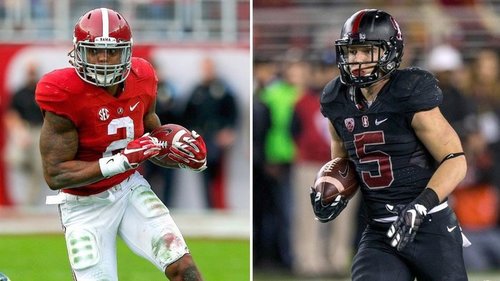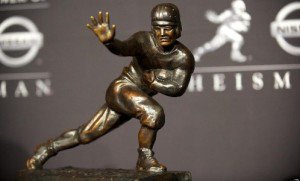For the second time in six years, a white running back from Stanford University came in second place in
Heisman Trophy balloting to a black running back from the University of Alabama. And for the second time, America may be getting a glimpse of the only
racial discrimination that
exists in sports—that
directed against whites.
![thetrophy]() Awarded to the nation’s best college football player, the Heisman Trophy is arguably the most illustrious individual award in all of sports. In 2009, Stanford white running back Toby Gerhart lost to Alabama’s Mark Ingram in what was the smallest margin of victory in the history of the award [The closest Heisman votes, by Chris Huston, Heisman, Accessed December 11, 2015] On Saturday night, Stanford’s sensational white running back Christian McCaffrey (still just a sophomore) lost to BAMA’s Derrick Henry.
Awarded to the nation’s best college football player, the Heisman Trophy is arguably the most illustrious individual award in all of sports. In 2009, Stanford white running back Toby Gerhart lost to Alabama’s Mark Ingram in what was the smallest margin of victory in the history of the award [The closest Heisman votes, by Chris Huston, Heisman, Accessed December 11, 2015] On Saturday night, Stanford’s sensational white running back Christian McCaffrey (still just a sophomore) lost to BAMA’s Derrick Henry.
This defeat is in spite McCaffrey’s jaw-dropping numbers, breaking the NCAA record for all-purposes yards (total yards from scrimmage combined for rushing, receiving, kickoff and punt returns) at 3,250 and scoring 13 total touchdowns in leading his team to a 12-2 record, a PAC-12 championship and a Rose Bowl Invitation. His total yards from scrimmage were more than 1,000 yards better than any other player in college football this season. In many ways, McCaffrey just put together the most incredible statistical season in the history of college football.
However, as a teammate put it, “[H]e definitely has a chip on his shoulder that people don't take him as seriously as he deserves" [Christian McCaffrey does everything, including break Barry Sanders' record, by Ted Miller, ESPN, December 6, 2015].
Why might they not take seriously McCaffrey—the son of legendary NFL receiver Ed McCaffrey? His mother, a soccer star at Stanford, once joked to Sports Illustrated the reason she married Ed was to “breed fast white guys,” and Christian seems to be proving her right [White Lightning, by Michael Silver, November 30, 1998].
But no matter fast he is, Christian McCaffrey is still white, and that’s a fatal disadvantage. ESPN’s Michael Wilbon called McCaffrey “the best player in college football by far,” but noted he’d have received more publicity nationally if he weren’t white. [ESPN’s Wilbon: Stanford RB McCaffrey Being White Hurts Heisman Chances, by Trent Baker, Breitbart, December 8, 2015]
White running backs who excel in high school are nonetheless stereotyped as inferior to black players. As recruiting guru Tom Lemming noted in Michael Lewis’s bestselling book The Blind Side: "And there were anti-types: Lord help the white receiver or the white running back, or until the earlier 1990s, the black quarterback." (p. 37)
A few years ago, head coach Bo Pelini of the University of Nebraska, had the opportunity to guide one of the few white running backs who got the chance to play big time college ball, Rex Burkhead. And Pelini admitted why so few whites are running backs and why those who do are described through clichés.
[Bo] Pelini can be very opinionated. He was in that type of mood Friday. He knows and we know why Burkhead gets tagged a "throwback player" and "overachiever," but we typically bite our tongue.Pelini let loose with the truth.
"Let's face it, people also say he's a white guy," the coach said. "People stereotype — that's what society does."
[Bo leads Burkhead bandwagon, by Steven Sipple, Lincoln Star Journal, July 27, 2012]
Burkhead is now a backup player for the Cincinnati Bengals.
Or consider Zach Zenner, a white running back who was an All-American at South Dakota State. He was one of the top pre-season NFL running backs this year, playing for the Detroit Lions. Before a season ending injury, Zenner not only made the team, but was actually starting. Josh Katzenstein of the Detroit News observed: “He has the elite athleticism that should help him avoid some of the stereotypical phrases often associated with white athletes in predominantly black sports, like scrappy, gritty or high motor. [Lions running back Zach Zenner a rare breed, August 22, 2015]
The reality: a white running back is seen as a liability both in college and in the NFL [White tailbacks out of the running, by Phil Taylor, Sports Illustrated, December 2, 2009]. Peyton Hills of the Cleveland Browns was often taunted on account of his race. Jacob Hester of Louisiana State (who had a short career with the NFL’s Denver Broncos) was called an “anachronism” in Sports Illustrated article because of his race, and was even asked by a black player, “Shouldn’t you be playing for Air Force?” [Tigers’ heart, by James Varney, NOLA, January 7, 2008].
![falconsanddubya]()
Why Air Force? The Air Force Academy’s high academic requirements led to one of the whitest rosters in college football. (Pictured right, the 2001 Air Force Academy Falcons with George W. Bush.) And in 2005, then-head coach Fisher DeBerry blamed a rare losing season on the lack of black players at the school:
“It just seems to be that way, that Afro-American kids can run very, very well. That doesn't mean that Caucasian kids and other descents can't run, but it's very obvious to me they run extremely well," DeBerry said in remarks first broadcast Tuesday night by KWGN-TV in Denver.[Air Force Coach Cites Lack of Black Players, Los Angeles Times, October 26, 2005]
But Stanford’s high academic standards seem to have combined with football success. Whereas most major college programs can recruit virtually any black high school recruit they want, with IQ held to be less important than their 40 yard dash time,
Stanford has an academic reputation to maintain:
Everything in college football starts with recruiting.Stanford administrators have estimated that only 400 of the 3,500 high school prospects who sign letters of intent each year meet their admissions standards. A year into the job, Harbaugh doubted that number.
"We're probably looking at a pool of 100 to 150 scholar-athletes," he said at the time. "It's a small pool. Smaller than anybody else has."
Toby Gerhart, the
white running back passed over for the Heisman in 2009, was only offered a chance to play running back at Stanford. The University of Southern California wanted to convert him to a fullback or linebacker [
One of a kind: Toby Gerhart succeeds at a position white players don't play at as much anymore, By Jenni Carlson,
NewsOk.com, December 11, 2009] But whereas other schools can rely on stereotypes and steer
physically talented morons towards jock-friendly majors, Stanford can’t afford to discriminate against the few talented
and also intelligent high schoolers they attract.
The result: In a six-year span, two white running backs at one school have nearly won most prestigious individual award in all sports. Another non-black running back at Stanford during this period, Tyler Gaffney, also met with some success, rushing for 1700 yards, 22 touchdowns, and being named a second-team All American and making the NFL.
And all this when you could count on two hands the number of white running backs who have started at other major colleges during this time span, or for that matter, the last 30 years.
The real story isn’t that two white running backs from the same school have finished in the top three balloting for the Heisman Trophy in six years. It’s that when white running backs are liberated from discrimination at just one school, they dominate.
![Opiate of America: College Football in Black and White Opiate of America: College Football in Black and White]() Paul Kersey[Email him] is the author of the blog SBPDL, and has published the books SBPDL Year One, Hollywood in Blackface and Escape From Detroit, Opiate of America: College Football in Black and White and Second City Confidential: The Black Experience in Chicagoland. His latest book is The Tragic City: Birmingham 1963-2013.
Paul Kersey[Email him] is the author of the blog SBPDL, and has published the books SBPDL Year One, Hollywood in Blackface and Escape From Detroit, Opiate of America: College Football in Black and White and Second City Confidential: The Black Experience in Chicagoland. His latest book is The Tragic City: Birmingham 1963-2013.




 Awarded to the nation’s best college football player, the
Awarded to the nation’s best college football player, the 










